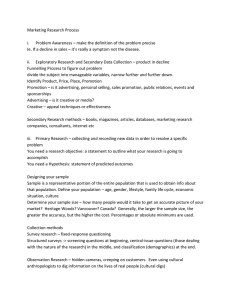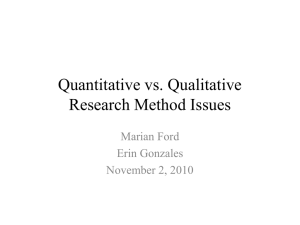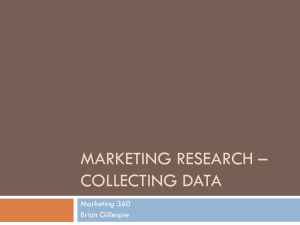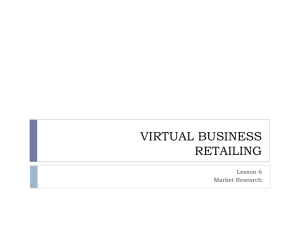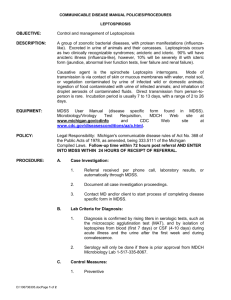CHAPTER 4:Customer analysis
advertisement
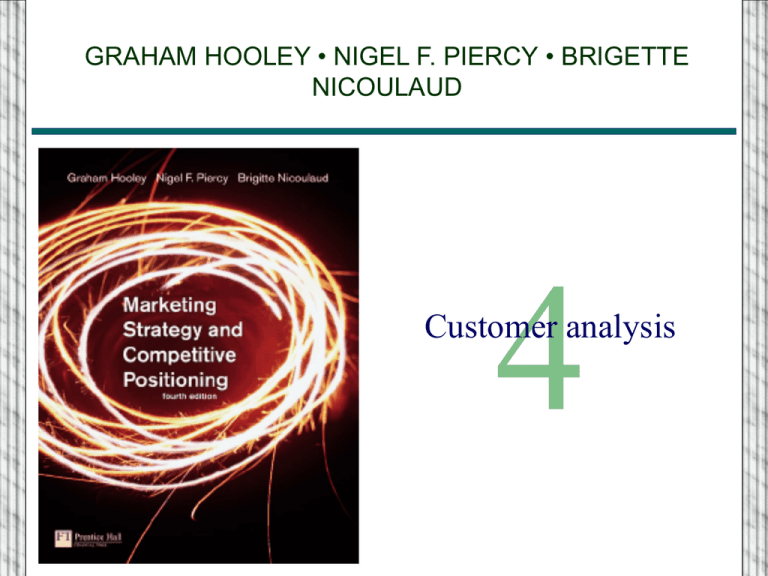
GRAHAM HOOLEY • NIGEL F. PIERCY • BRIGETTE NICOULAUD 4 Customer analysis Introduction • Information; raw material for decision making • Marketing research; provision of information to reduce level of uncertainty in decision making • Chapter includes; – Information needs about customers – Research techniques for collecting data – Uses of these techniques i.e. creating & segmenting market and identifying current and potential product/service positions 6-2 What we need to know about customers • Grouped into current and future information • Critical issues concerning current customers; – – – – Who are the prime market targets? What give them value? How they can be brought closer? How can they be better served? • For future, we also need to know; – How will customers and their needs and requirements change? – Which new customers should we pursue? – How should we pursue them? 6-3 Figure 4.1 Who is the customer? Initiator User/consumer Purchaser Purchase, use and consumption Influencer Decider 6-4 Information on current customers • Recognizing five roles can be useful in targeting marketing activity – The initiator – initiates the research for solution to consumer’s problem – The influencer – influence on purchase decision – The decider – actually make the decision – The purchaser – buys the product or service – The user – consumes the product or service • Different approaches may be suitable 6-5 Figure 4.2 Understanding customers-the key questions WHO Is involved in buying and consuming? HOW WHAT Do they use the product? Are their choice criteria? CUSTOMERS WHERE WHEN Do they buy? Do they buy/use the product? WHY Do they buy/use the product? 6-6 Information on future customers • Two main types of change essential to customer analysis – First; change in existing customers their wants, needs and expectations (Kaizen approach) – Second; new customers emerging as potentially more attractive targets • Main way to analyze customers is through marketing research and market modeling 6-7 MARKETING RESEARCH 6-8 Marketing-research methods Figure 4.3 Marketing research methods Tailor-maid research Company records Sales records Accounts records Experiments Observation Field Laboratory Off-the-peg research Quantitative research Qualitative research Surveys Focus groups Depth interviews Personal Telephone Postal Desk research Shared & syndicated Internet 6-9 Company records • Company’s own records – Data about who purchase and how much purchase may be obtained from invoice records – Purchase records may show customer loyalty pattern • Identify gaps in customer purchasing and highlight most valuable customers • Collect routine data on as detail a basis as possible for unforeseen data requirements 6-10 Off-the-peg research • Tapping into existing research services; data that are already in existence – Information such as market size, growth rates, economic trends • Crouch and Housden classify research as; – Secondary or desk research – Syndicated research – Shared research 6-11 Secondary desk research • Data already been published by someone else • Advantages; – Relatively cheap, quick to obtain, can be reliable and accurate i.e. govt. publications • Disadvantages; – Out of date and not specific enough, vary dramatically in quality, both from country to country and supplier to supplier 6-12 Following question must be born in mind to check accuracy of secondary data 1. Who collected the data and why? (Are they likely to be biased in their reporting?) 2. How did they collect the data? (Sample or census? Sampling method? Research instrument?) 3. What level of accuracy do they claim? (Does the methodology support the claim?) 4. What use did they put the data to? (Is its use limited?) 6-13 Syndicated research • Research buyers share costs and findings of research among themselves • Conducted by marketing research agencies and sold to whoever will buy • Examples are A.C. Nelsen, TCA, AGB, TGI etc • Advantages; methodology usually tried and tested, samples are often bigger • Disadvantages; data are limited in usefulness 6-14 Shared research • Some of the costs and fieldwork are shared by number of companies but not results • Advantages; – Established methodologies and are relatively quick and cheap to tap into • Disadvantages; – Its scope and number of questions that can be asked 6-15 Tailor-made research • Flexibility to design the research to exactly match the need of the client company • Categorized as quantitative and qualitative research – Qualitative research emphasize gaining understanding and depth in data that can not be quantified – Quantitative research involves large samples and produces quantifiable outputs 6-16 Qualitative techniques • Unstructured or semi-structured interviewing methods • Two main techniques are used; group discussion and individual depth interviews • Group discussion take the form of relaxed, informal discussion among 7-9 respondents • The Depth interview takes place between one interviewer and one respondent 6-17 Figure 4.4 Uses of qualitative research Providing insights into problems Generating new ideas Having customer descriptions of things Qualitative research Helping structure later research Getting reactions to new ideas Understanding the findings of large-scale projects 6-18 Quantitative techniques • Include surveys, observation methods and experimentation • Surveys are vast subject in themselves • Surveys include three types; personal interviews, telephone interviews and postal surveys (mail) 6-19 Figure 4.5 Uses of surveys To provide quantitative data on markets and customers To determine customer behavior To determine customer requirements and expectations Surveys To determine customer opinions and perceptions To provide data for segmentation of markets 6-20 Surveys Personal interviews Telephone interviews Advantages Advantages • Greatest flexibility • Useful in attitudinal statements, • Data is acquired quickly • Low cost • Closely controlled Disadvantages Disadvantages • Most expensive to conduct • Every one may not have telephone 6-21 Surveys (Cont’d) Postal methods Advantages Disadvantages • Cheapest of all • Useful in locating geographically disperse samples • Low response rate • Little control over who responds • Requires clearly laid out questionnaire, well pretested to insure clarity 6-22 Observation techniques • Observation techniques can be particularly useful where respondents are unlikely to be able or willing to give the types of information required – Observing what items a shopper has taken from supermarket shelf, considered for purchase but not bought 6-23 Experimentation • Experiments are either carried out in the field or in-house (laboratory) • Field experiments take place in the real world • In-house experiments are conducted in more controlled but less realistic settings 6-24 Figure 4.6 Uses of experimentation To establish the strength of relationship To establish causation To test elements of the strategy Experiments To estimate market potential To test customer reactions to alternative strategies 6-25 THE MARKETING RESEARCH PROCESS 6-26 Figure 4.7 Stages in a comprehensive marketing research project Problem definition Exploratory research Quantitative research Analysis and interpretation 6-27 Problem definition • Define clearly the problem to be tackled • Series of discussion between marketing research personal and marketing decision maker are necessary 6-28 Exploratory research • Identify information gaps and specify the need for further research • Initially secondary sources and company records can be utilized • Qualitative research might then be used to explore 6-29 Quantitative research • Help in formulating hypothesis about how market is segmented and what factors influence purchase • Followed by quantitative study – Ask respondents to evaluate competing products • Experimentation might also be used in quantitative phase of segmentation 6-30 Analysis and interpretation • Turn the data generated into meaningful information – Factor analysis – Cluster analysis – Perceptual mapping • Finally results will be presented to senior marketing decision-maker 6-31 Organizing customer information • Information is organized through MIS • Information system (MIS) has five basic components; – Market research interface to collect data – The raw data collected – Statistical techniques used to analyze – Market models to utilize raw data and statistical techniques – Finally managerial interface as decision maker 6-32 Figure 4.8 Marketing decision support systems Marketing decision-maker Statistical techniques Market models Decisions Responses Managerial interface Raw data Marketing research interface Marketing environment 6-33 Raw data • Data come into system from variety of sources, from internal and external primary and secondary sources • Stored in various forms i.e. paper, people’s head, on computer 6-34 Statistical techniques • Synthesize and analyze the raw data • Commonly used statistics are averages, means, standard deviations, ranges etc • Market models – Model is representation of the real world 6-35 Marketing decision support systems • Change in emphases in marketing from information systems (MIS) to marketing decision support systems • Provision of question and answer facilities • Grouped into two types; • Data-oriented decision support systems, – Data retrieval and simple analysis using statistical techniques • Model-oriented decision support systems – Simulation and representation of aspects of the real world 6-36 Characteristics of MDSS • MDSS support decisions! – Support rather than replace, managerial decision making • MDSS are essentially interactive – Ask questions, receive inputs and experiment with decision • MDSS should be flexible and easy to use 6-37
